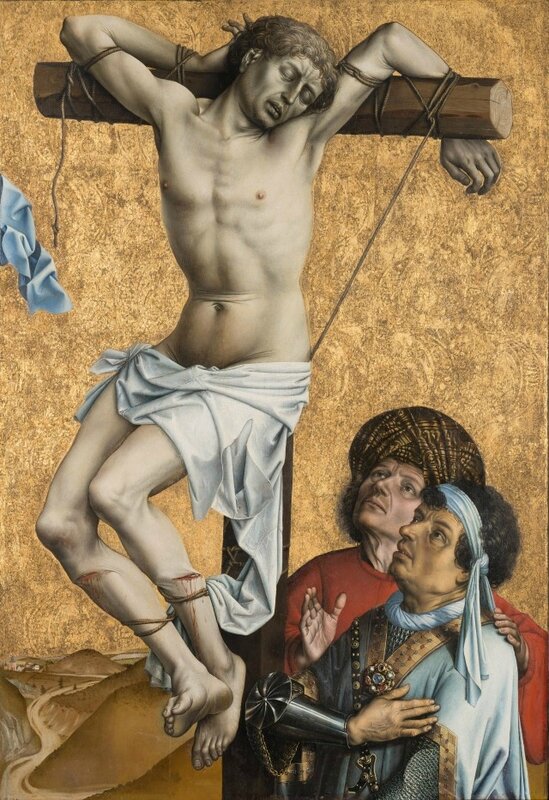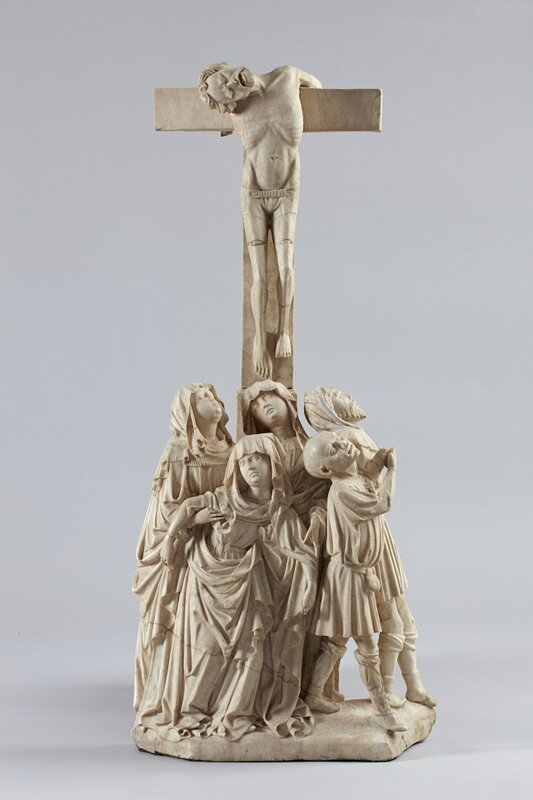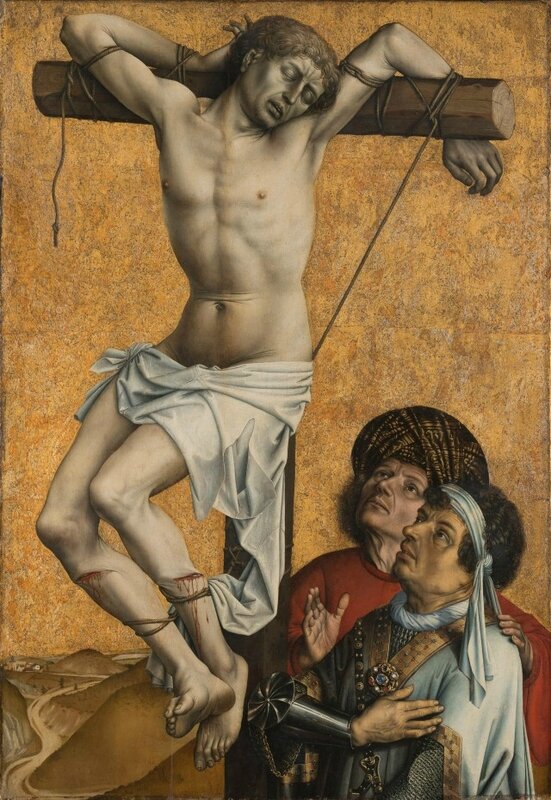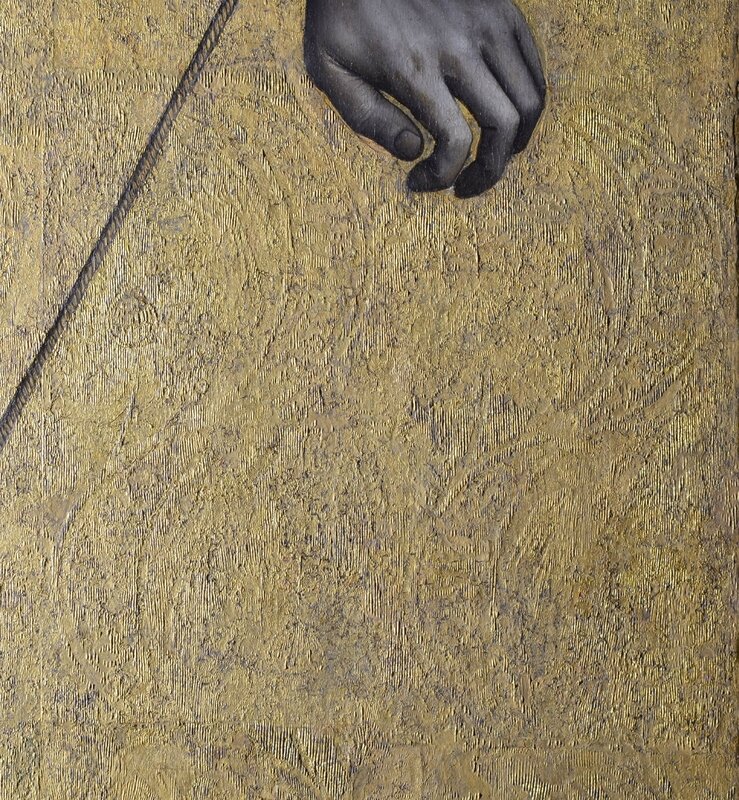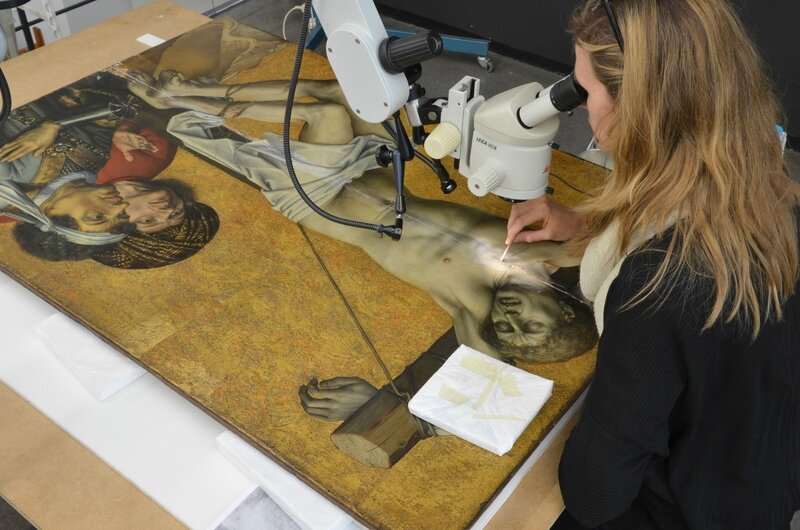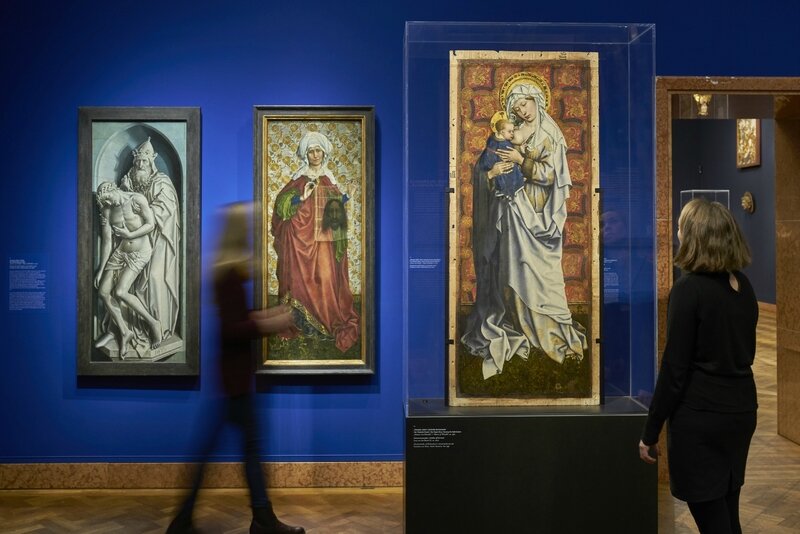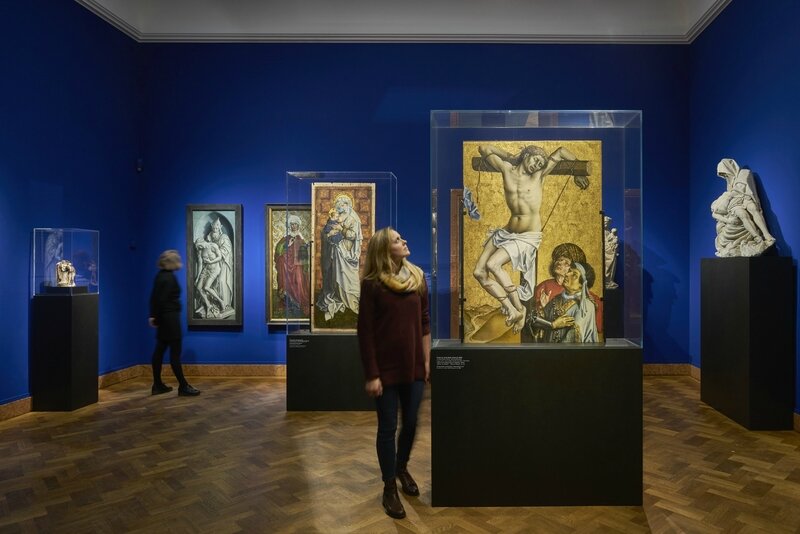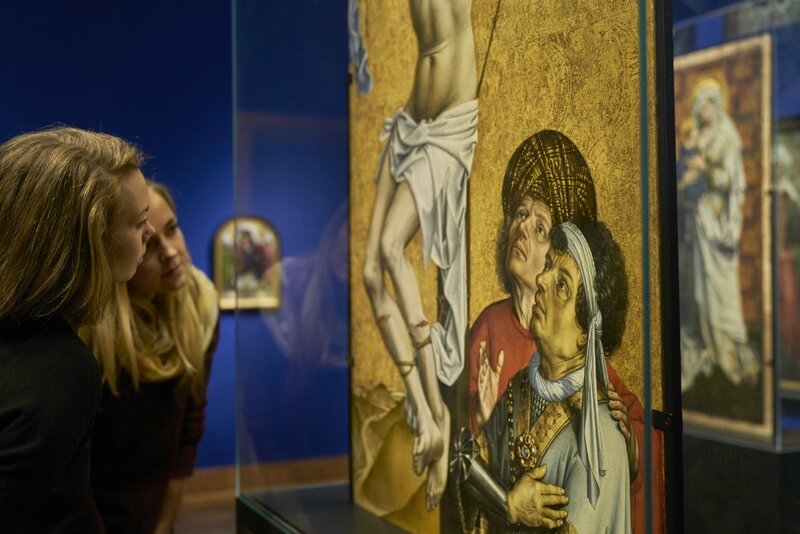![1]()
The former wing inside with the representation of the crucified Schächers after completion of the restoration. “Master of Flémalle”, Thief on the left of Christ / John the Baptist, c. 1430. Mix media on wood, 134,2 x 92,5 cm, Frankfurt am Main, Städel Museum. Foto: Städel Museum
FRANKFURT.- The Liebieghaus Skulpturensammlung is presenting a special exhibition revolving around a work of key significance to the history of European art: the so-called Crucified Thief by the “Master of Flémalle”, one of the most enigmatic figures of Early Netherlandish painting.
Comprehensive examination and restoration of the fragment got underway at the Städel Museum in October 2014. Painted on both sides, it is the only surviving section of a large-scale triptych of the Deposition that was among the most prominent and influential works of Netherlandish painting at the beginning of the fifteenth century.
Now that the conservation and restoration measures have reached completion, the precious work literally shines with new splendour. The exhibition sheds light on the procedure and spectacular outcome of the technological examination and the restoration. It also features thirteen selected comparanda in the mediums of sculpture, panel painting, drawing and book illumination, serving to contextualize the fragment in a wide variety of ways.
“With New Splendour. The Restored Crucified Thief by the Master of Flémalle in Context” is the first presentation ever to bring works together that, as early copies, testify to the fame of the original altarpiece while at the same time providing the basis for reconstructing that nonextant overall ensemble. The selection includes such outstanding loans as a painted copy from the Walker Art Gallery in Liverpool, one drawing each from the Fogg Art Museum in Cambridge (Mass., USA) and the Fitzwilliam Museum in Cambridge (UK), and the Book of Hours of Katharina van Lochorst from the Westfälisches Landesmuseum für Kunst und Kulturgeschichte in Münster. The fragment is moreover being shown in conjunction with Netherlandish and German sculptures of the period in question, which is splendidly represented at the Liebieghaus by the so-called Rimini Altarpiece and Hans Multscher’s Holy Trinity. The two last-named works are currently undergoing comprehensive restoration measures themselves, and the exhibition provides suspenseful insights into those projects. One prominent result of the restoration of the Crucified Thief is the recovery of its fascinating illusion of three-dimensionality, a characteristic of the painting of the “Master of Flémalle” that stands out all the more saliently in the show through its dialogical juxtaposition with masterworks of Netherlandish and German sculpture. An entirely new experience of the sophisticated manner in which the “Flémaller” played with contemporary visual expectations, but also of the competition between painting and sculpture in the early fifteenth century, awaits the visitor.
![lh_presse_schaecher_stundenbuch_katharina_lochorst_1440_0]()
Master of Catherine of Cleves: Descent from the Book of the Cloister by Katharina van Lochhorst, c. 1450 (detail of fol. 106v). LWL-Museum für Kunst und Kultur (Westfälisches Landesmuseum), Münster. Foto: LWL-Museum für Kunst und Kultur (Westfälisches Landesmuseum), Münster /Sabine Ahlbrand.-Dornseif
![lh_presse_schaecher_rimini_liebieghaus_links]()
"Master of the Rimini altar" and workshop, Group with a Thief from a Crucifixion, c. 1430. Alabaster, minimum remains of original paint, 46,5 x 38 x 14,5 cm. Liebieghaus Skulpturensammlung , Frankfut am Main. Foto: Liebieghaus Skulpturensammlung
"Master of the Rimini altar" and workshop, A group of a crucifixion, around 1430. Alabaster, minimum remains of original paint, 46,5 × 38 × 14,5 cm. Liebieghaus Skulpturensammlung , Frankfut am Main. Foto: Liebieghaus Skulpturensammlung.
![lh_presse_schaecher_riminischaecher_privatbesitz_1430]()
"Master of the Rimini altar" workshop, Thief to the right of Christ, around 1430. Alabaster, ca. 35 x 20 cm. Private collection. Foto: private.
![lh_presse_schaecher_multscher_trinitaet]()
Hans Multscher (c. 1400-1467), Trinity with angels, around 1430. Alabaster, supplemented during Baroque, original polychromy, retouched, 28,5 x 16,3 x 10,2 cm. Liebieghaus Skulpturensammlung, Frankfurt am Main. Foto: Liebieghaus Skulpturensammlung
The exhibition “With New Splendour. The Restored Crucified Thief by the Master of Flémalle in Context” is being carried out jointly by the Städel Museum and the Liebieghaus Skulpturensammlung and supported by the Kulturfonds Frankfurt RheinMain. The conservation and restoration of the Crucified Thief was supported through a grant from the Bank of America Merrill Lynch Art Conservation Project.
“The ongoing study, conservation and restoration of the holdings are among the museum’s traditional core responsibilities, and thus also among its most distinguished. As the exhibition so impressively demonstrates, both the Liebieghaus Skulpturensammlung and the Städel Museum dedicate themselves to these responsibilities with as much a sense of duty as of passion. What is more, we attach very special importance to making our scientific findings – in the areas of art history as well as the technological investigation of paintings – accessible to a broad public”, emphasizes Dr Philipp Demandt, the director of the Liebieghaus and the Städel Museum.
“The Crucified Thief by the ‘Master of Flémalle’ holds a prominent position in Early Netherlandish painting. The chequered history of the original work from altarpiece to fragment, from sacred object to panel painting, and the countless measures it has been subjected to over the course of nearly six hundred years led to our wish to carry out a fundamental evaluation. Thanks to the latest restoration, the painting’s specific forcefulness, which results from the subtle manner in which the artist juggled with visual expectations and pictorial realities, now comes into its own in a very striking way”, observes Prof Dr Jochen Sander, the curator of the exhibition and head of the collection of German, Dutch and Flemish painting before 1800 at the Städel Museum.
“The conservation and restoration work concentrated primarily on the press brocade that constitutes the background of the Crucified Thief. The fragment is one of the earliest surviving examples of this technique of imitating precious gold brocade fabrics, and in its execution one of the most exceptional. Owing to a great loss of material as well as later revisions, the finely detailed ornamental relief structure was no longer legible. The chief focus of the restoration measures was therefore on removing later measures that interfered with a clear reading, and on harmoniously replacing the missing parts. Through the removal of coatings with the help of laser, it was possible to make the press brocade perceivable once again in its material design as a gold surface”, explains conservator Annegret Volk, who under the supervision of Stephan Knobloch, the head of painting restoration at the Städel Museum, was charged with the scientific research and the realization of the restoration concept for the Crucified Thief.
The Crucified Thief by the “Master of Flémalle”
The Crucified Thief once formed the upper half of the right wing of a monumental altarpiece presumably executed for a Bruges church or chapel around 1430 and meanwhile completely lost except for this fragment. In its open state it showed the Deposition of Christ between the two thieves who had been executed with him. In its closed state, it displayed the simulated sculptures of St John the Baptist and another figure, probably Christ. Like the altarpiece to which the Städel Museum’s “Flémalle panels” belonged (the works from which the master’s name of convenience derives), which has likewise survived only in fragments, the Deposition triptych was executed around 1430. In the Netherlandish art of the fifteenth century there are numerous indications that the “Flémaller’s” Deposition caused quite a sensation among his contemporaries.
The “Master of Flémalle” is one of the most enigmatic artists of Early Netherlandish painting. Contrary to what the name of convenience suggests, what lies concealed behind this name is not a clearly definable individual but an entire group of painters. The artist Robert Campin of Tournai had brought them together in his workshop between 1426/27 and 1432 for the execution of several major altarpieces. One of them was Rogier van der Weyden. In 2008, in cooperation with the Staatliche Museen zu Berlin, the Städel Museum devoted the first comprehensive exhibition ever to the “Master of Flémalle” and Rogier van der Weyden. That show moreover investigated the unresolved questions of art history with regard to ‘ars nova’, the revolutionary new painting style that emerged in the Burgundian Netherlands and, with its realistic representation of reality down to the smallest detail, marked the commencement of modern art at the beginning of the fifteenth century.
![lh_presse_schaecher_kreuzabnahme_triptychon_liverpool_ganz]()
Master of the Bruges Ursulalegende (circle), Descent from the Cross, a copy of the Descent from the Cross of the "Master of Flémalle", last third 15th century. Oak wood mixing technique, 59.9 × 26.5 cm (left wing), 59.0 × 60.2 cm (center panel), 59.6 × 26.3 cm, (right wing), Walker Art Gallery, Liverpool. Foto: © National Museums, Liverpool
![lh_presse_schaecher_kreuzabnahme_triptychon_liverpool_links]()
Master of the Bruges Ursulalegende (circle), Depiction of the Deposition of the Cross, copy of the Deposition of the Deposition of the "Master of Flémalle", last third of the 15th century (left wing). Mixed technique on oak wood, 59.9 × 26.5 cm (left wing), Walker Art Gallery, Liverpool. Foto: © National Museums, Liverpool
![lh_presse_schaecher_kreuzabnahme_triptychon_liverpool_mitte]()
Master of the Bruges Ursulalegende (circle), Depiction of the Deposition of the Cross, copy of the Deposition of the Deposition of the "Master of Flémalle", last third of the 15th century (middle panel). Mixed media on oak, 59,0 × 60,2 cm (middle panel), Walker Art Gallery, Liverpool. Foto: © National Museums, Liverpool
![lh_presse_schaecher_kreuzabnahme_triptychon_liverpool_rechts]()
Master of the Bruges Ursulalegende (circle), Depiction of the Deposition of the Cross, copy of the Deposition of the Deposition of the "Master of Flémalle", last third of the 15th century (right wing). Mixed technique on oak wood, 59.6 × 26.3 cm, (right wing), Walker Art Gallery, Liverpool. Foto: © National Museums, Liverpool
![lh_presse_schaecher_nachzeichnung_mitteltafel_cambridge]()
Dutch Master, Descent from the Cross, tracing of the middle panel of the Deposition of the Depiction of the Cross by the "Master of Flémalle", last third of the 15th century. brush drawing in ink, bodycolour and red chalk on dark-grey prepared ground (washed paper), , 26,7 x 25,7 cm, The Syndics of the Fitzwilliam Museum, University of Cambridge, Cambridge (UK). Foto: © The Fitzwilliam Museum, Cambridge
Restoration
A thorough technological investigation, an ethical discussion of the restoration concept, and an assessment of the risks posed by the various measures preceded the comprehensive restoration of the Crucified Thief. Immediately after the severely damaged altarpiece fragment was purchased in 1840, it was subjected to several restoration measures that strongly dominated its appearance until very recently. Supplements to the background that deviated in structure and colour from the gold press brocade of the original were especially disturbing, as were the coatings that had been applied. What is more, a vertical crack in the panel had been stabilized with a strip of wood on the outside of the wing. To that end, it had been necessary to plane off the painting (at the time overpainted in black) in the area of the crack. The aim of the restoration was to enable the viewer to experience the work in all its facets once again. On the one hand, the aesthetic focus was to be shifted away from the infelicitous past restoration measures to the original painting’s exceptional quality. On the other hand, the press brocade was to be made perceivable again in its elaborate, relief-like design and as a gold surface. Both aspects contribute to allowing viewers to rediscover the special qualities in the design of the Crucified Thief, the manner in which the artist(s) played with the material limitations, the various pictorial levels and the wealth of detail. A further very important goal was to ensure the continued legibility of the work’s fragmentary character – after all, it is not a panel painting in the modern sense, but part of a larger overall ensemble of a late medieval altarpiece. This aspect will be vividly brought to bear in the show with the aid of a new presentation concept, the omission of a frame, the installation in a display case to allow viewing from all sides, and the exposure of a corner of an angel’s robe fluttering over from the central panel – a detail that had been gilded over when the original altarpiece was destroyed.
![before]()
The former wing inside with the representation of the Schächers before the restoration. “Master of Flémalle”, Thief on the left of Christ / John the Baptist, c. 1430. Mix media on wood, 134,2 x 92,5 cm, Frankfurt am Main, Städel Museum. Foto: Städel Museum
![lh_presse_schaecher_innenseite_detail_vor_zwischen_endzustand_final]()
The detail of the two soldiers in pre-, intermediate- and final state shows an example of the change of the painting during the restoration. "Master of Flémalle", Thief on the left of Christ / John the Baptist, around 1430. Mixed technique on oak wood, 134.2 x 92.5 cm, Frankfurt am Main, Städel Museum. Foto: Städel Museum
![lh_presse_schaecher_detail_goldgrund]()
Detail of a complete press brocade sheet after the reconstruction and gilding of the original sample. Foto: Städel Museum
![lh_schaecher_fragment_aussenseite_kurz_vor_abschluss_der_restaurierung]()
The former wing outside just before completion of the restoration. Foto: Städel Museum
![lh_presse_schaecher_fragment_aussenseite_vorzustand]()
The former wing outside with the depiction of John the Baptist at the beginning of the project. Foto: Städel Museum.
![lh_presse_schaecher_fragment_blick_atelier_schulter]()
View over the shoulder during the restoration of the Schachen fragment. Foto: Städel Museum.
![lh_presse_schaecher_fragment_blick_atelier_laser]()
View into the working room during the varnish removal from the press brocade using a Nd: YAG laser. Foto: Städel Museum.
![lh_presse_in_neuem_glanz_ausstellungsansicht_1]()
![lh_presse_in_neuem_glanz_ausstellungsansicht_2]()
![lh_presse_in_neuem_glanz_ausstellungsansicht_3]()
![lh_presse_in_neuem_glanz_ausstellungsansicht_4]()
![lh_presse_in_neuem_glanz_ausstellungsansicht_5]()
![lh_presse_in_neuem_glanz_ausstellungsansicht_6]()
![lh_presse_in_neuem_glanz_ausstellungsansicht_7]()
![lh_presse_in_neuem_glanz_ausstellungsansicht_8]()
![lh_presse_in_neuem_glanz_ausstellungsansicht_9]()
Exhibition views of “With New Splendour: The Restored Crucified Thief by the Master of Flémalle in Context”. Photo: Liebieghaus Skulpturensammlung.









